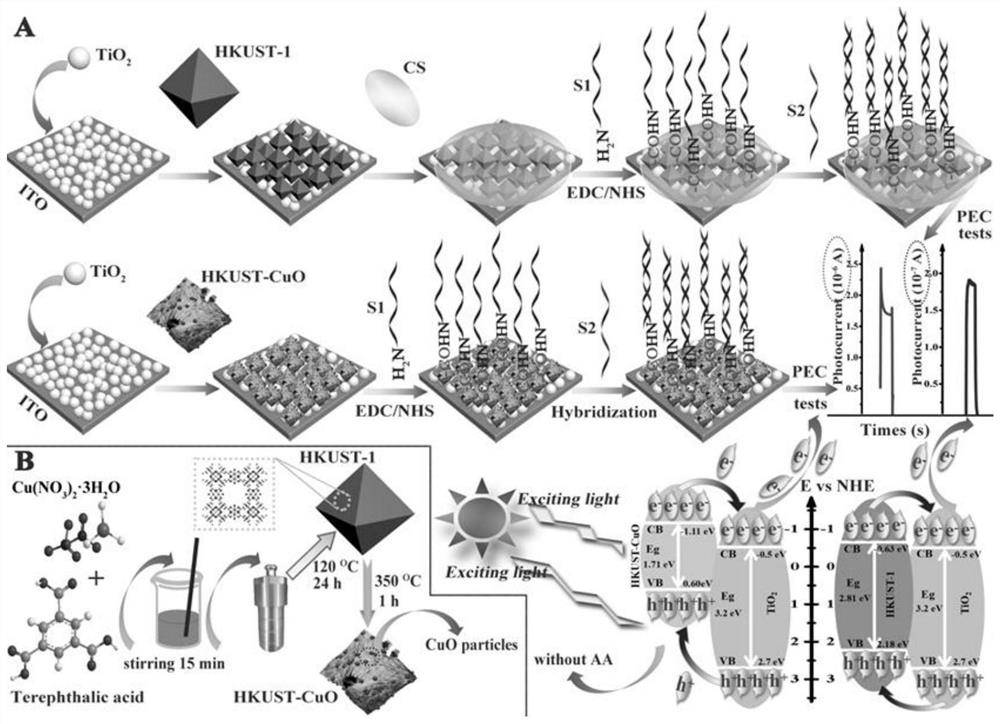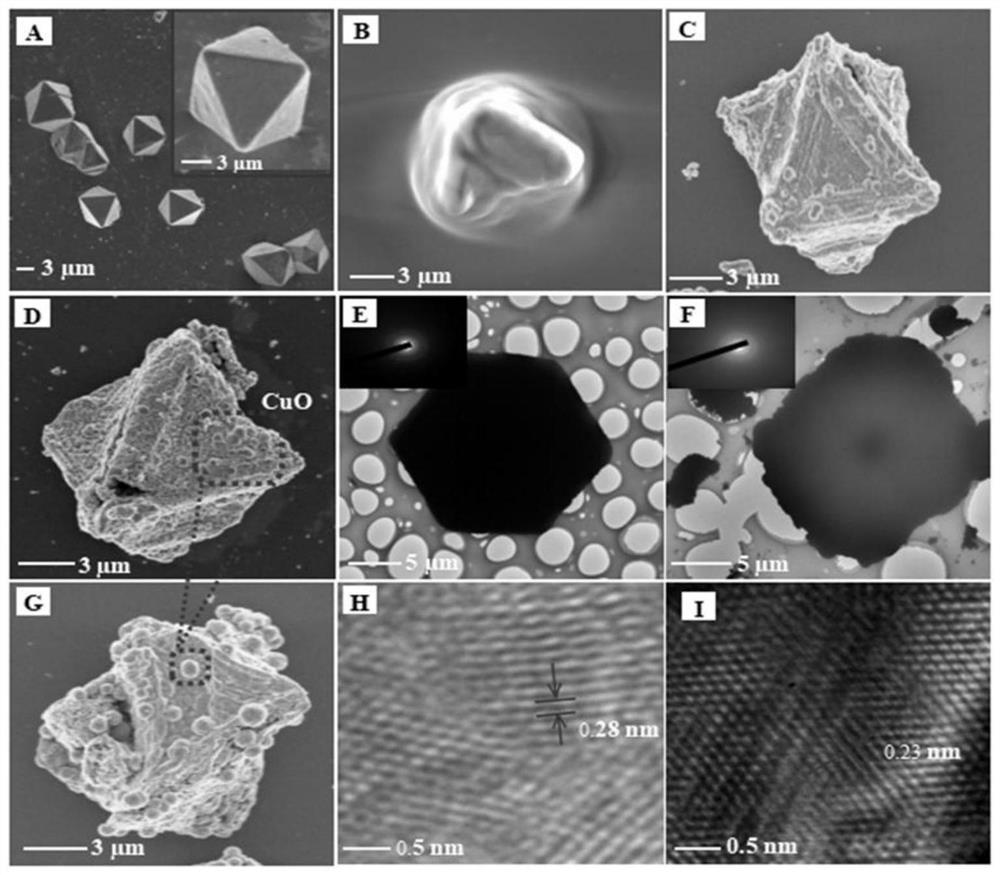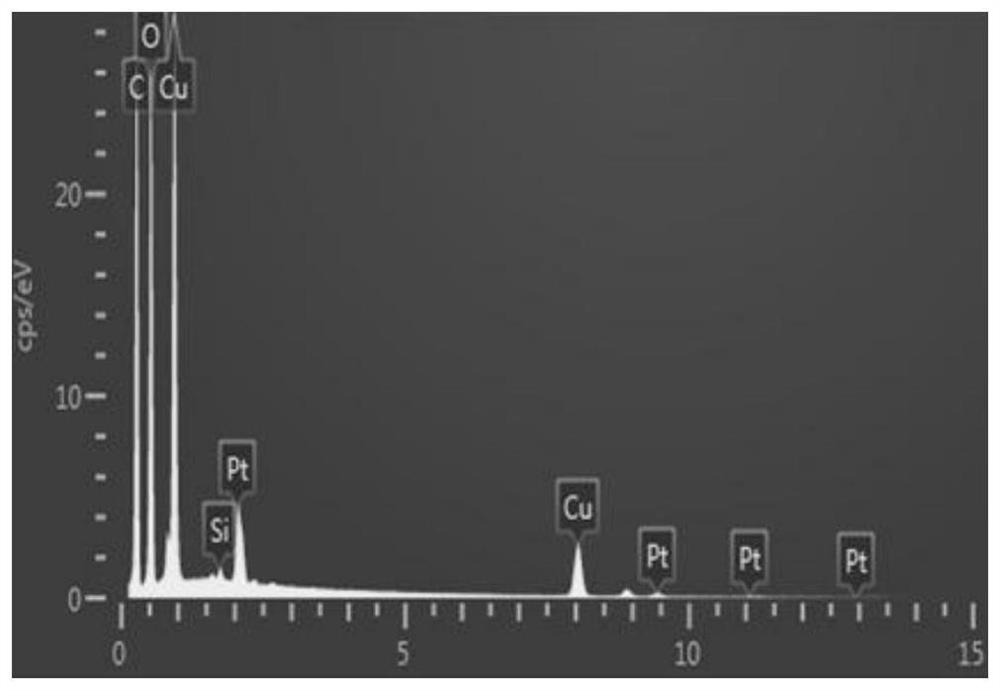Preparation method and application of MOFs composite TiO2 photoactive material electrode
A composite electrode and photoactive technology, applied in the direction of material electrochemical variables, color/spectral characteristic measurement, material analysis using wave/particle radiation, etc., to achieve enhanced sensitization effect, high light absorption efficiency, and improved conversion efficiency
- Summary
- Abstract
- Description
- Claims
- Application Information
AI Technical Summary
Problems solved by technology
Method used
Image
Examples
Embodiment 1
[0052] A kind of MOFs composite TiO 2 Preparation methods of photoactive material electrodes, such as figure 1 As shown, it mainly includes the following steps:
[0053] 1. Synthesis of HKUST-1 octahedron
[0054] HKUST-1 was prepared by hydrothermal solvent method. Mainly include: weigh 0.535g Cu(NO 3 ) 2 ·3H 2 O (2.21mmol) and 0.234g BTC (tribenzoic acid) (1.11mmol) were added to 8mL of deionized water and 8mL of ethanol solution respectively, after stirring for 15min, the two solutions were mixed and ultrasonicated under the condition of 50W power Treat for 10 min to obtain a uniformly dispersed mixed solution. Then, the mixture was transferred to a 100 mL stainless steel reactor and kept at 120 °C for 24 h. Naturally cooled to room temperature, centrifuged with water / ethanol (1:1, volume ratio) (8000rpm, 10min) to wash the product three times, and finally, the precipitate was vacuum-dried at 60°C for 12h to obtain blue HKUST-1 particles . Scanning electron microsc...
Embodiment 2
[0063] A composite TiO based on MOFs 2 The preparation method of the photoelectrochemical biosensor of photoactive material electrode, its schematic diagram, such as figure 1 shown. Taking the biosensor for detecting Escherichia coli toxin DNA as an example, its specific preparation method is as follows:
[0064] The DNA sequence adopted in this embodiment is as follows:
[0065] Capture probe sequence (S1): 5'-NH 2 -(CH 2 ) 6 -GAG CGG CGC AAC ATT TCA GGT CGA-3';
[0066] Complementary sequence (S2): 5'-TCG ACC TGA AAT GTT GCG CCG CTC-3';
[0067] Single base mismatch sequence (S3): 5'-TCG ACC TGA AAT GTT GCG CCT CTC-3';
[0068] Three base mismatch sequence (S4): 5'-TCG TCC TGA AAC GTT GCG CCT CTC-3';
[0069] Non-complementary sequence (S5): 5'-GCA CGG CGC AAC ATT TCA GGT CGA-3';
[0070] Using EDC / NHS as activator to convert 5'-NH 2 The modified probe NDA was covalently immobilized on the surface of the modified electrode through amidation reaction. The preparati...
experiment example 1
[0073] Application of the photoelectrochemical (PEC) biosensor prepared in Example 2 in the detection of Escherichia coli toxin DNA (S2)
[0074] The analytical performance of the probe (S1) modified electrode is as follows: Figure 10 Shown in B. Under optimal experimental conditions, the prepared two PEC biosensors with increasing target DNA concentration (C S2 ) hybridization reaction, the photocurrent signal obtained gradually decreases, and their photocurrent change value (ΔI) is related to the logarithm of the DNA concentration (log C S2 ) show a good correspondence. For S1 / CS / HKUST-1 / TiO 2 / ITO sensor, its detection linear range is 1.0×10 -6 nM~4.8×10 -2 nM, the detection limit based on 3 times the signal-to-noise ratio (S / N=3) is 6.31×10 -7 nM, the linear regression equation is ΔI(10 -7 A)=0.6052-0.2023log(C S2 / M)(R 2 =0.9969)( Figure 10 C). For S1 / HKUST-CuO / TiO 2 / ITO sensing platform ( Figure 8 E and F), which exhibit a wider linear detection range (1...
PUM
| Property | Measurement | Unit |
|---|---|---|
| concentration | aaaaa | aaaaa |
Abstract
Description
Claims
Application Information
 Login to View More
Login to View More - R&D
- Intellectual Property
- Life Sciences
- Materials
- Tech Scout
- Unparalleled Data Quality
- Higher Quality Content
- 60% Fewer Hallucinations
Browse by: Latest US Patents, China's latest patents, Technical Efficacy Thesaurus, Application Domain, Technology Topic, Popular Technical Reports.
© 2025 PatSnap. All rights reserved.Legal|Privacy policy|Modern Slavery Act Transparency Statement|Sitemap|About US| Contact US: help@patsnap.com



